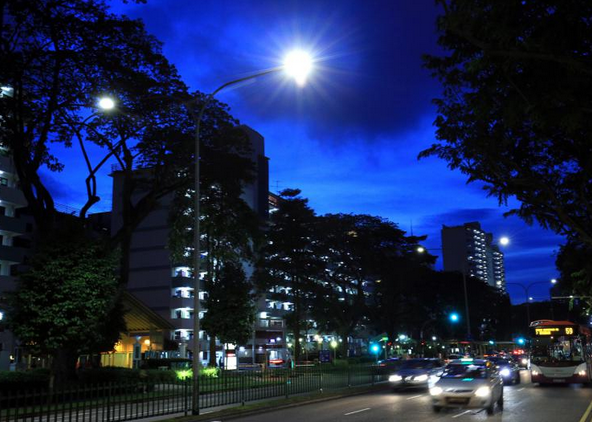
News Center
Singapore wants to build a national sensor network with 100,000 street lights
- Categories:Industry information
- Time of issue:2017-03-27 17:11
(Summary description) According to statistics, there are nearly 100,000 street lights in Singapore. The Singapore government intends to use this ready-made and extensive infrastructure to build a nationwide sensor network to collect various data such as closed-circuit television images, humidity or temperature for various government agencies. Interconnected lamp posts are expected to become the main element of Singapore’s national sensor network Singapore’s Prime Minister Lee Hsien Loong once said that the four large-scale technology plans that the government is discussing and launching will drastically change the existing mode of operation. Among them, it includes the sensor network covering all corners of Singapore, which can collect CCTV images from sources such as traffic police, ditches, or elevators or security cameras installed in HDB areas, and integrate all image data to become a comprehensive set of national data source. It is understood that the sensor network will be built on the basis of existing street lighting facilities. With nearly 100,000 street lights nationwide as the backbone facilities, there is no need to allocate additional funds to build new infrastructure. Currently, the Land Transport Authority of Singapore has launched a tender, intending to replace more energy-saving LED lights for all street lights before 2022, and adopt a new remote monitoring system that can switch street lights according to weather conditions. In January, the Singapore Land Transportation Authority disclosed in a statement that the Government Science and Technology Agency will use this new smart street light system to test whether it can launch a shared network with low-bandwidth wireless sensors. The Land Transportation Bureau said that as part of the vision of a smart country, interconnected lampposts are expected to become the main element of the national sensor communication network. When reviewing the contents of the bidding document, it can be found that there are two options that the authorities can exercise in the bidding for the construction of hardware and software equipment. The first option is to launch a trial for shared use, allowing government agencies other than the Land Transportation Bureau to install and manage their own sensors on smart street lights. During the test, the number of sensors running at the same time is expected to reach 50, and the test period will be at least six months. It is understood that the sensor can collect data such as volume, temperature, humidity, rainfall, water level and water flow. The contractor must also ensure that the sensor network can transmit images as large as 1M every 30 seconds. In addition, the contractor must ensure that all data is encrypted and protected during transmission, and the system should also have a way to identify the authenticity of all sensors and users to be connected to the system to prevent data leakage. The second option is to expand the above experiment so that different government agencies that install their own sensors can use the same set of software applications. The test at this stage must support approximately 1,000 simultaneous sensors. The tender ends on April 4. Network security is a major concern At the same time, some people in related companies said that the biggest concern of this approach is network security, because so many sensors may become a loophole in the central system, and if this central system is connected to traffic lights, or even Singapore’s national power supply, etc. Other systems may cause major problems. However, network security should not become an obstacle for the government not to introduce new technologies, but to be fully prepared to deal with it. However, it was also pointed out that sensor networks have little impact on personal privacy. The reason is that the so-called big data is not data that focuses on small details. Even if the images collected by closed-circuit television can identify citizens' personal identities, if citizens have no criminal intentions and have legitimate behaviors in public places, this should not cause any trouble to citizens, but will further curb the occurrence of crimes. Some government officials in the country also believe that the national sensor network will help promote government services that benefit citizens and businesses, including flooding prevention and combating criminals, but at the same time, the government must protect the privacy of citizens.
Singapore wants to build a national sensor network with 100,000 street lights
(Summary description) According to statistics, there are nearly 100,000 street lights in Singapore. The Singapore government intends to use this ready-made and extensive infrastructure to build a nationwide sensor network to collect various data such as closed-circuit television images, humidity or temperature for various government agencies.
Interconnected lamp posts are expected to become the main element of Singapore’s national sensor network
Singapore’s Prime Minister Lee Hsien Loong once said that the four large-scale technology plans that the government is discussing and launching will drastically change the existing mode of operation. Among them, it includes the sensor network covering all corners of Singapore, which can collect CCTV images from sources such as traffic police, ditches, or elevators or security cameras installed in HDB areas, and integrate all image data to become a comprehensive set of national data source.
It is understood that the sensor network will be built on the basis of existing street lighting facilities. With nearly 100,000 street lights nationwide as the backbone facilities, there is no need to allocate additional funds to build new infrastructure. Currently, the Land Transport Authority of Singapore has launched a tender, intending to replace more energy-saving LED lights for all street lights before 2022, and adopt a new remote monitoring system that can switch street lights according to weather conditions.
In January, the Singapore Land Transportation Authority disclosed in a statement that the Government Science and Technology Agency will use this new smart street light system to test whether it can launch a shared network with low-bandwidth wireless sensors. The Land Transportation Bureau said that as part of the vision of a smart country, interconnected lampposts are expected to become the main element of the national sensor communication network.
When reviewing the contents of the bidding document, it can be found that there are two options that the authorities can exercise in the bidding for the construction of hardware and software equipment.
The first option is to launch a trial for shared use, allowing government agencies other than the Land Transportation Bureau to install and manage their own sensors on smart street lights. During the test, the number of sensors running at the same time is expected to reach 50, and the test period will be at least six months.
It is understood that the sensor can collect data such as volume, temperature, humidity, rainfall, water level and water flow. The contractor must also ensure that the sensor network can transmit images as large as 1M every 30 seconds. In addition, the contractor must ensure that all data is encrypted and protected during transmission, and the system should also have a way to identify the authenticity of all sensors and users to be connected to the system to prevent data leakage.
The second option is to expand the above experiment so that different government agencies that install their own sensors can use the same set of software applications. The test at this stage must support approximately 1,000 simultaneous sensors. The tender ends on April 4.
Network security is a major concern
At the same time, some people in related companies said that the biggest concern of this approach is network security, because so many sensors may become a loophole in the central system, and if this central system is connected to traffic lights, or even Singapore’s national power supply, etc. Other systems may cause major problems. However, network security should not become an obstacle for the government not to introduce new technologies, but to be fully prepared to deal with it.
However, it was also pointed out that sensor networks have little impact on personal privacy. The reason is that the so-called big data is not data that focuses on small details. Even if the images collected by closed-circuit television can identify citizens' personal identities, if citizens have no criminal intentions and have legitimate behaviors in public places, this should not cause any trouble to citizens, but will further curb the occurrence of crimes.
Some government officials in the country also believe that the national sensor network will help promote government services that benefit citizens and businesses, including flooding prevention and combating criminals, but at the same time, the government must protect the privacy of citizens.
- Categories:Industry information
- Time of issue:2017-03-27 17:11


Top Ranking
RECOMMEND NEWS
Top Ranking
RECOMMEND NEWS
ONLINE MESSAGE
WRITE A MESSAGE TO US
v
Contact us
Tel:
+86 731-86171990
Email:
sales@firstratesensor.com
Address: 4th Floor, Building 1, Zhitingyuan, Zhenhua Road, Yuhua District, Changsha City, Hunan Province,China.







